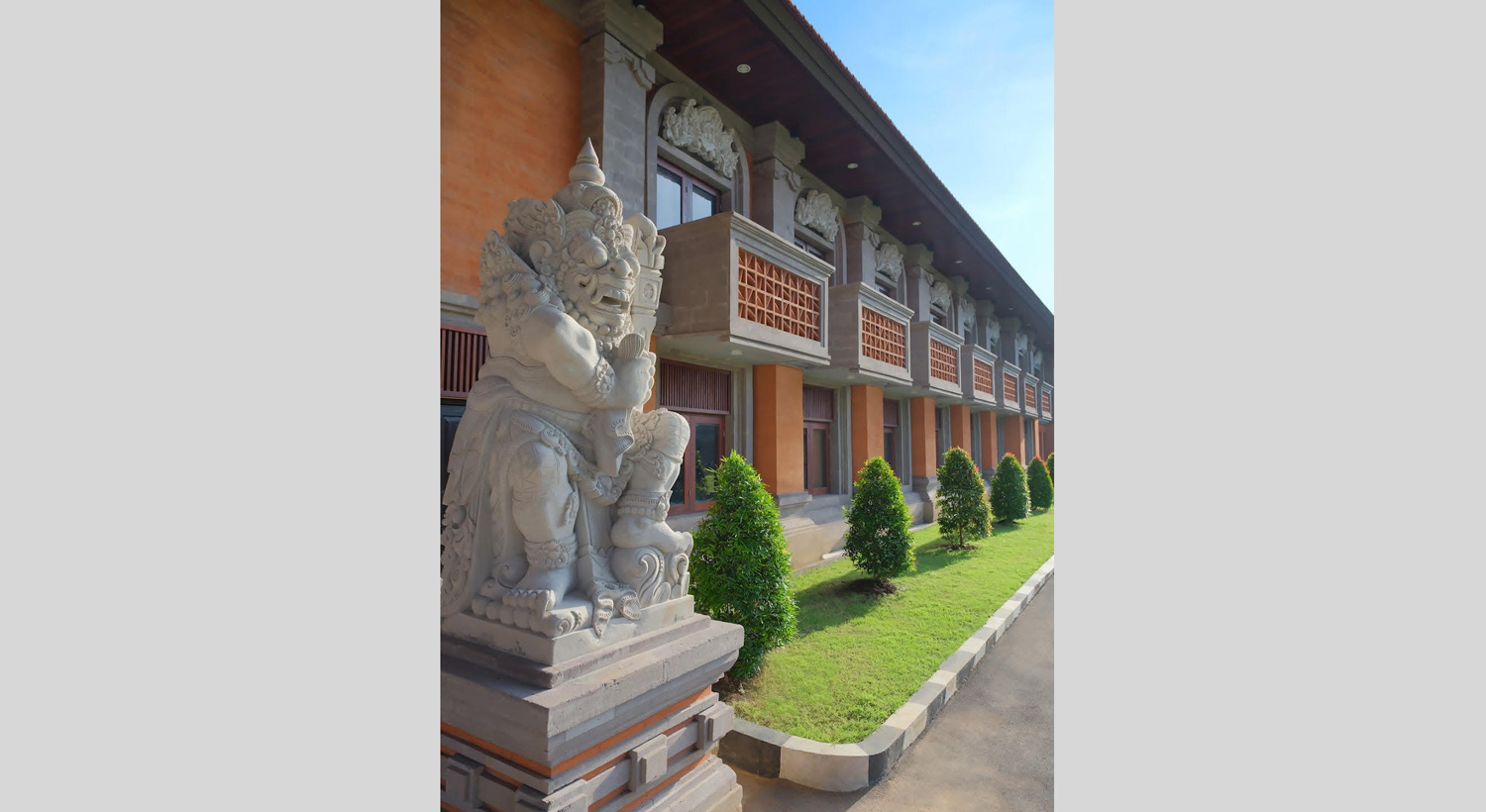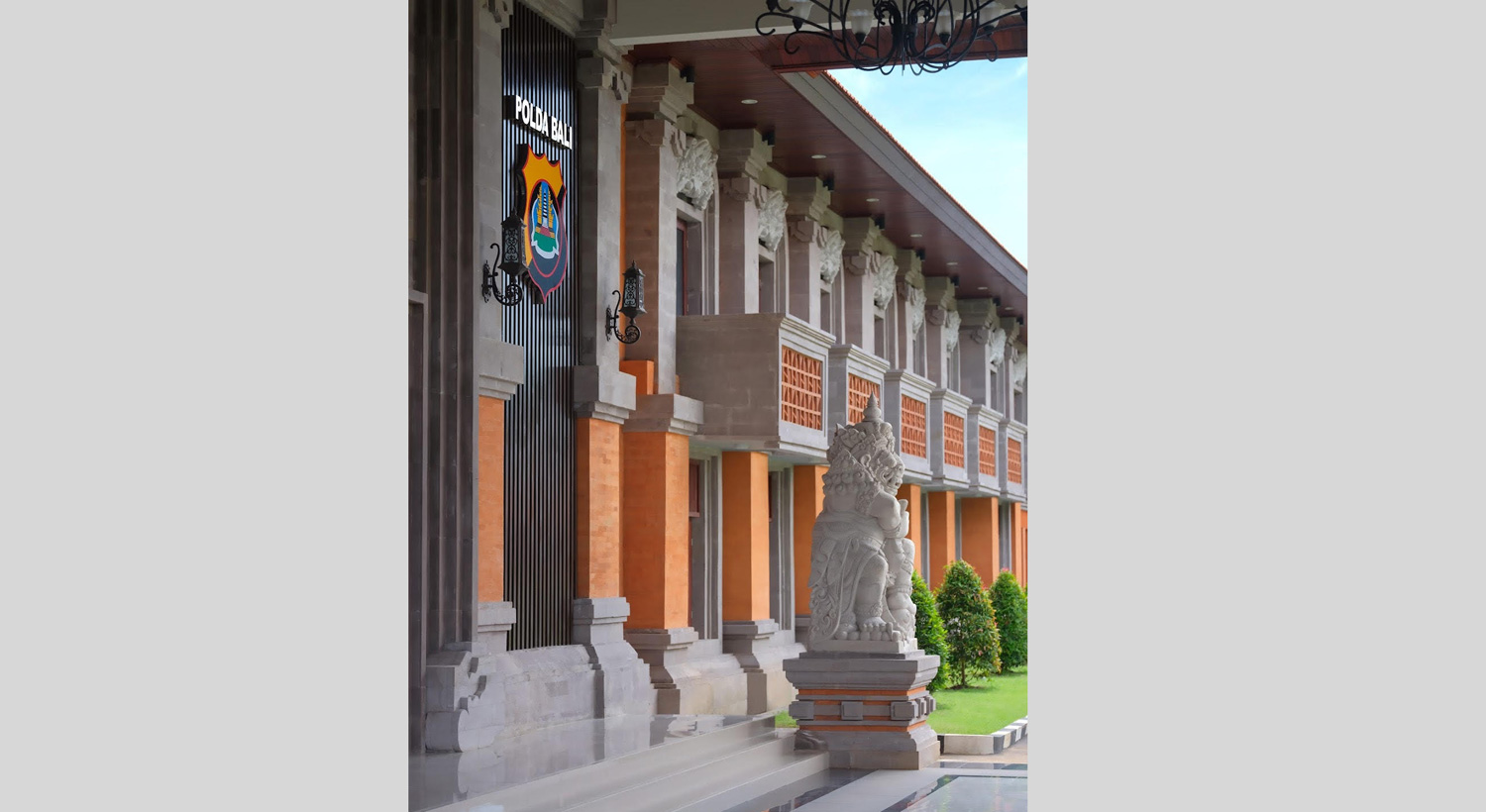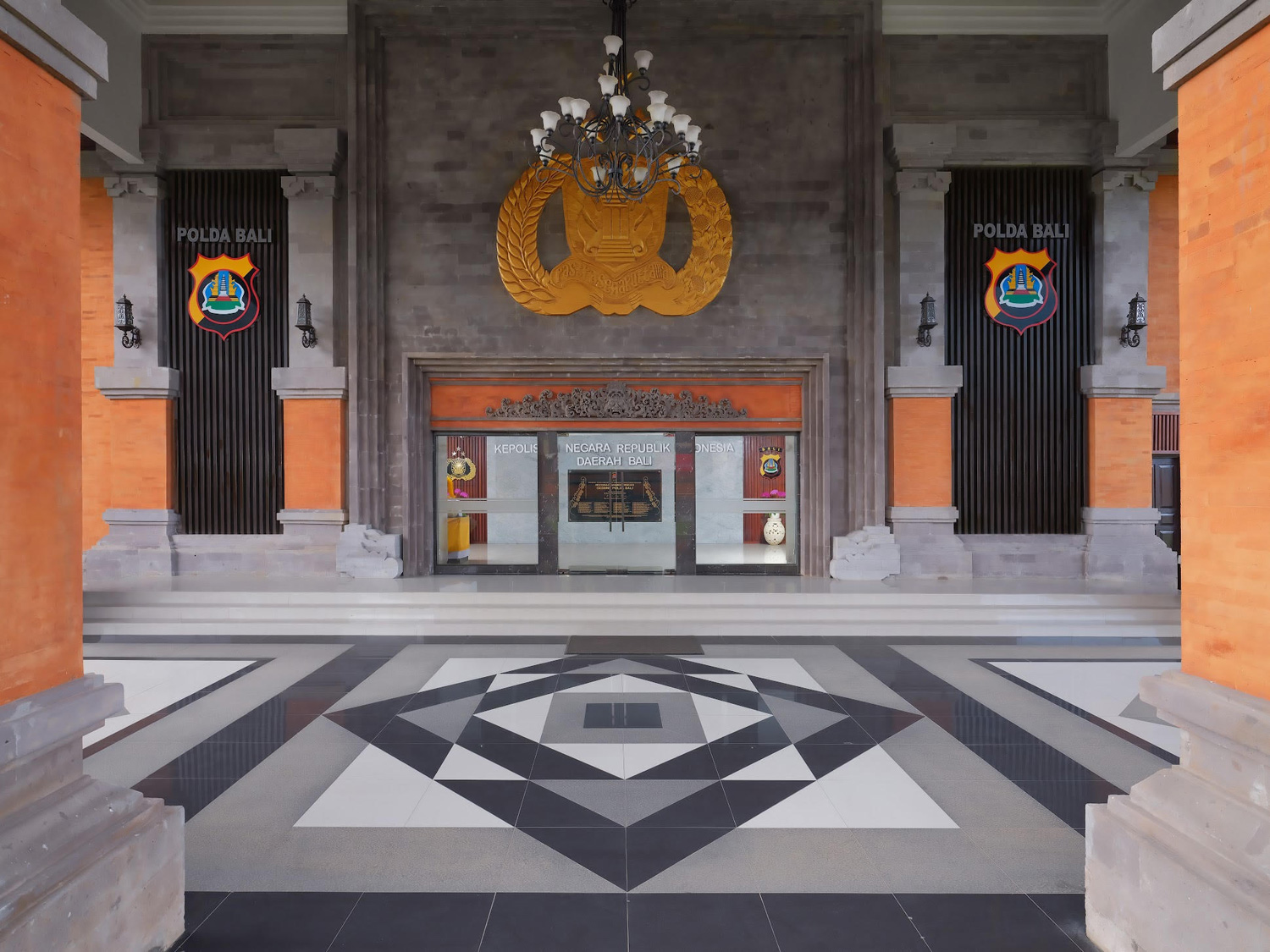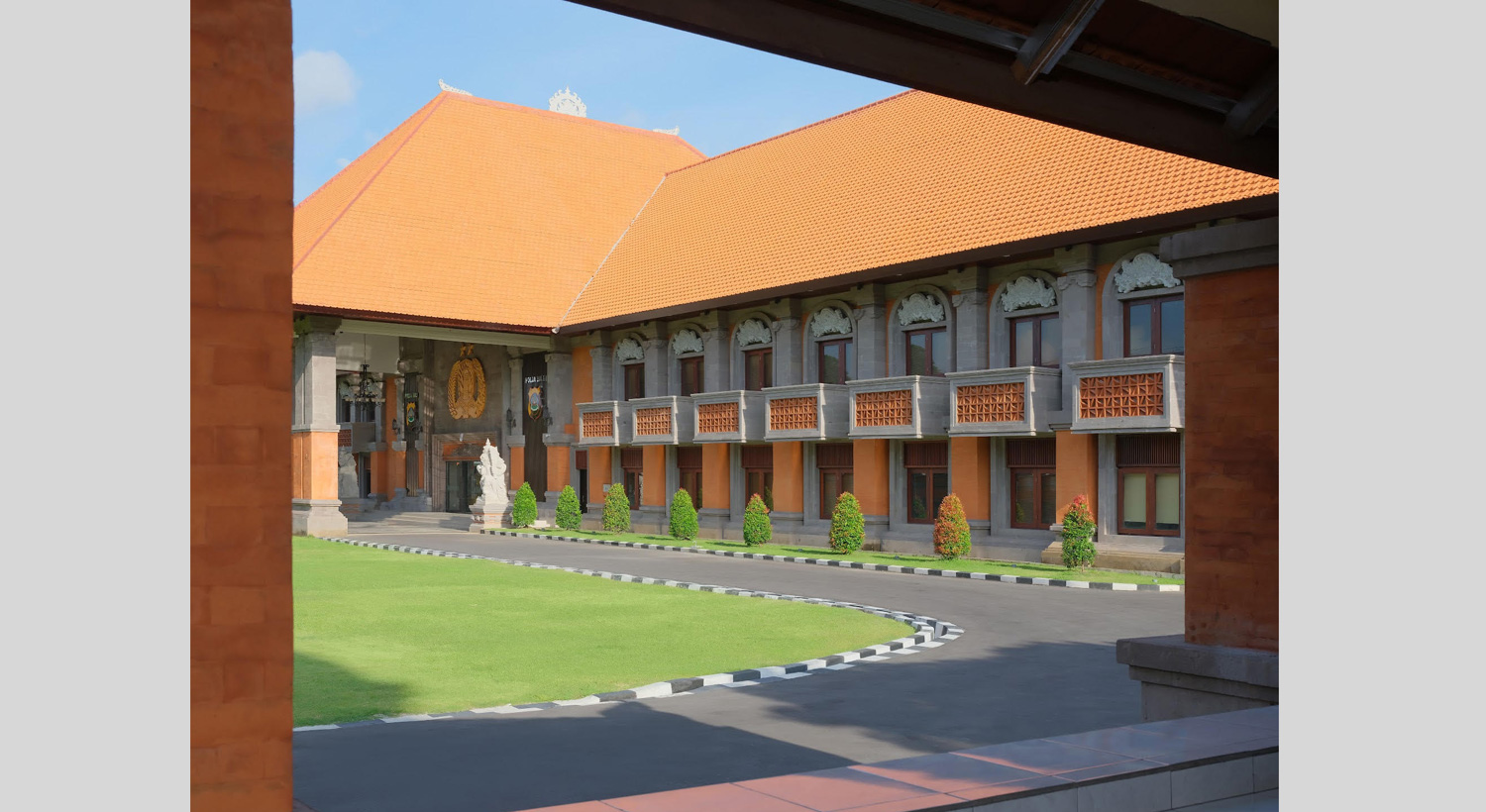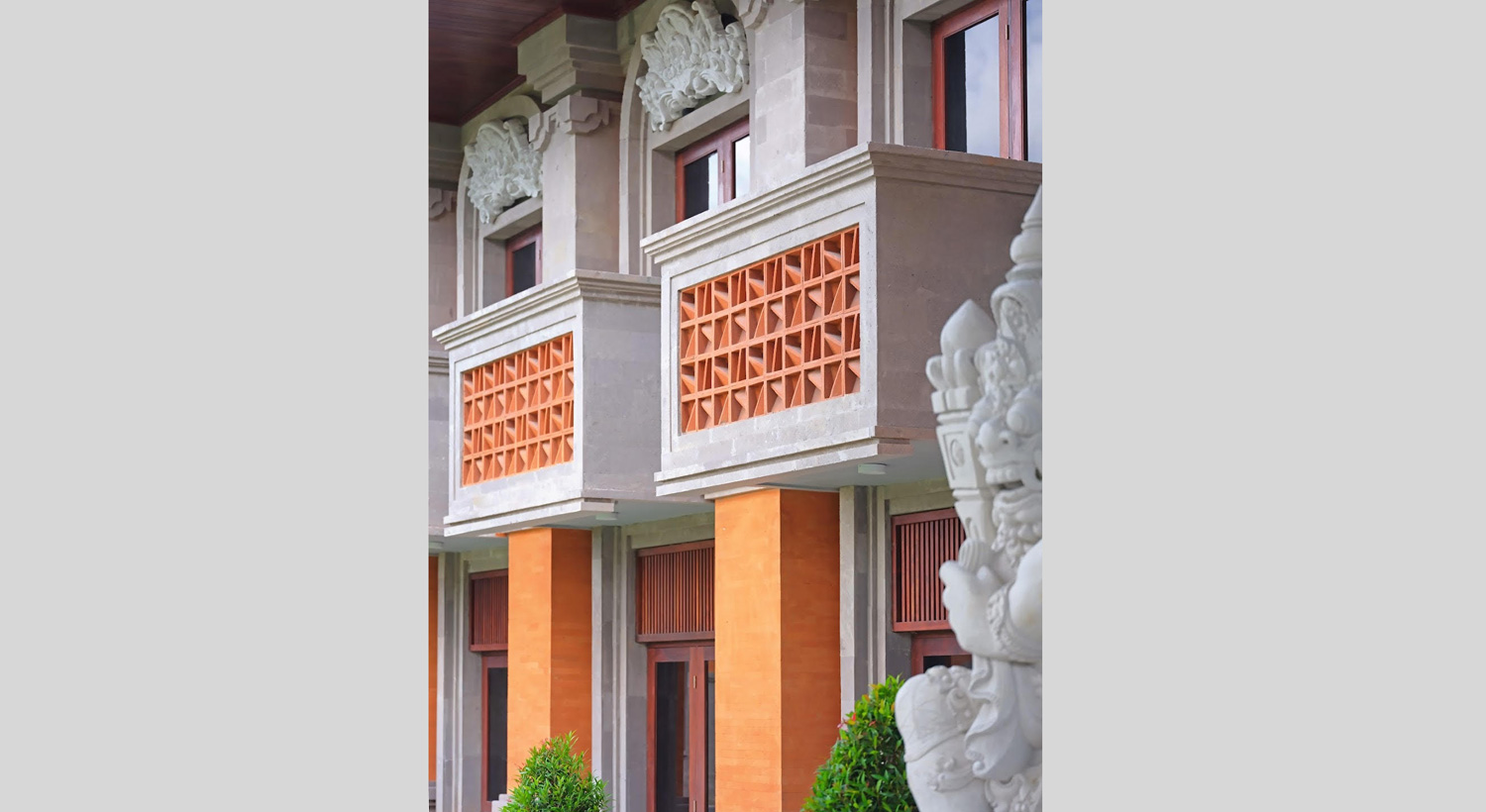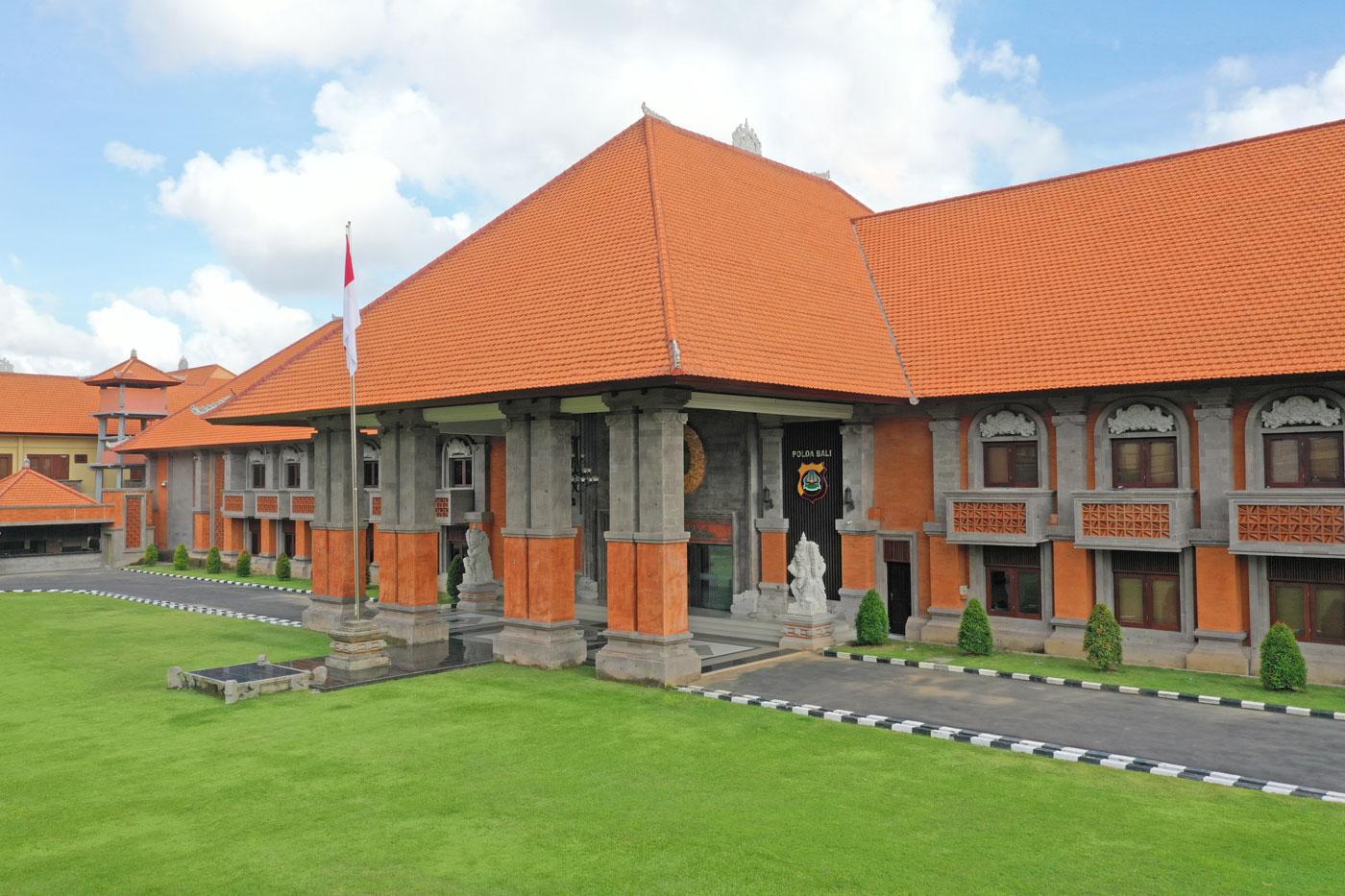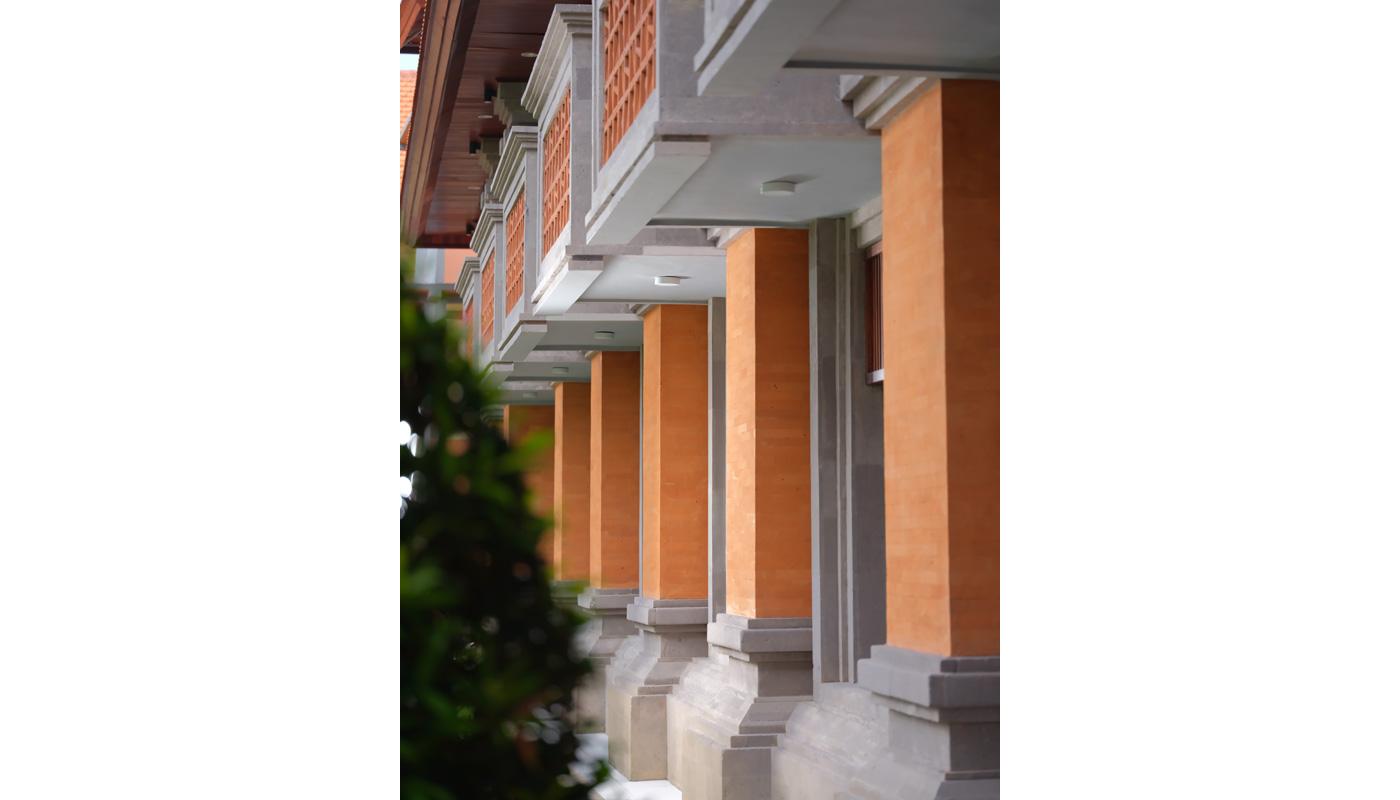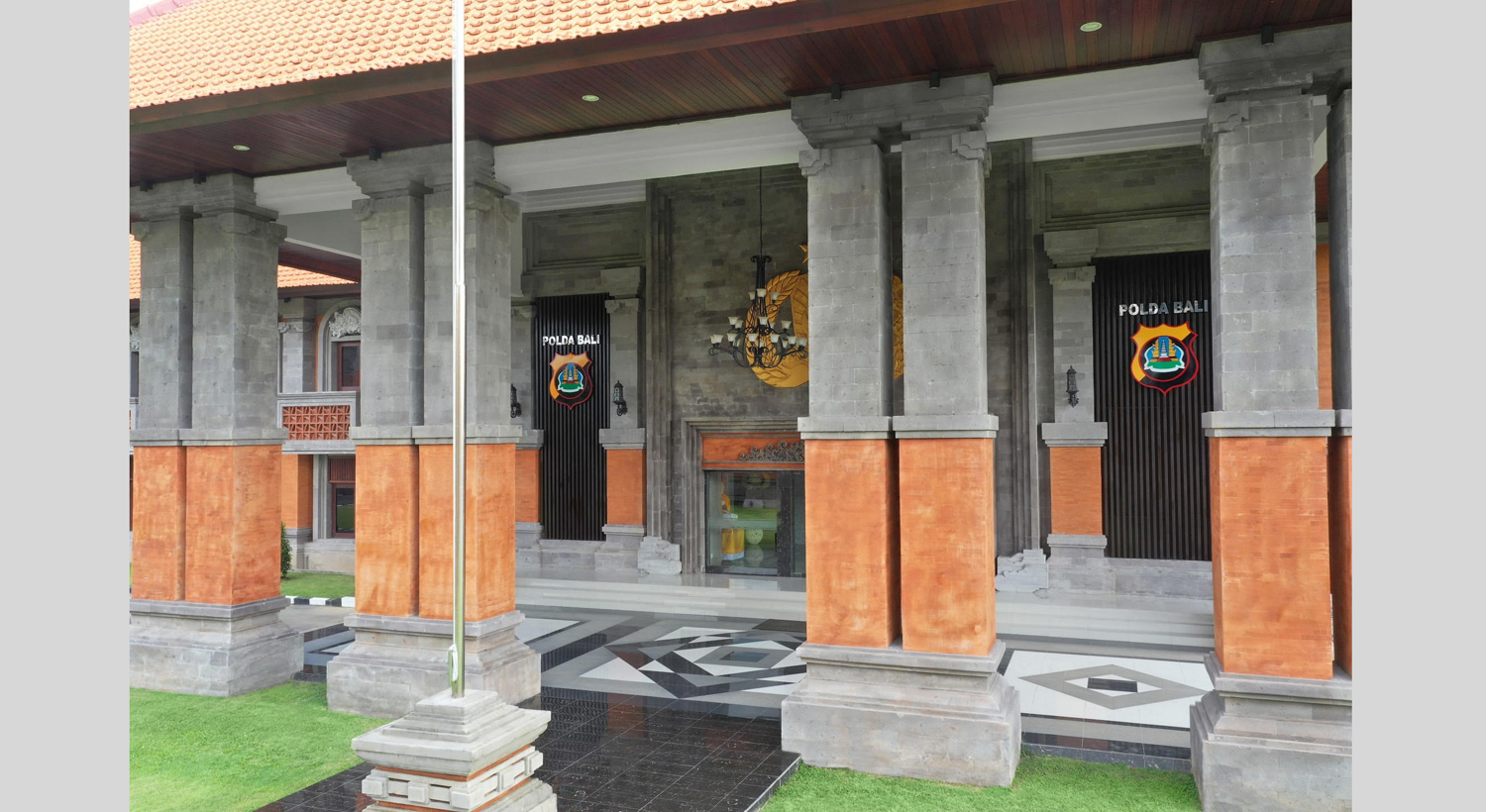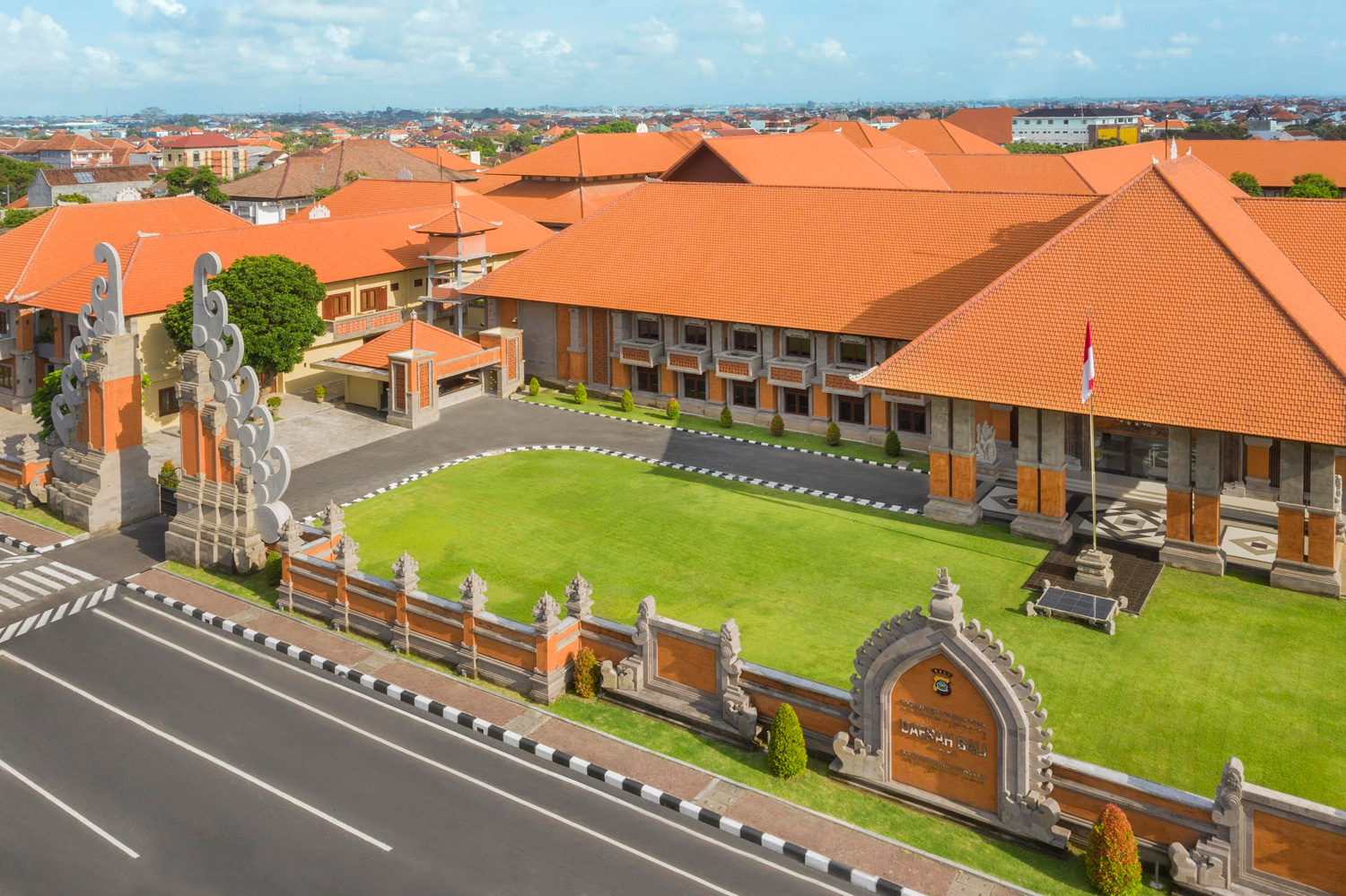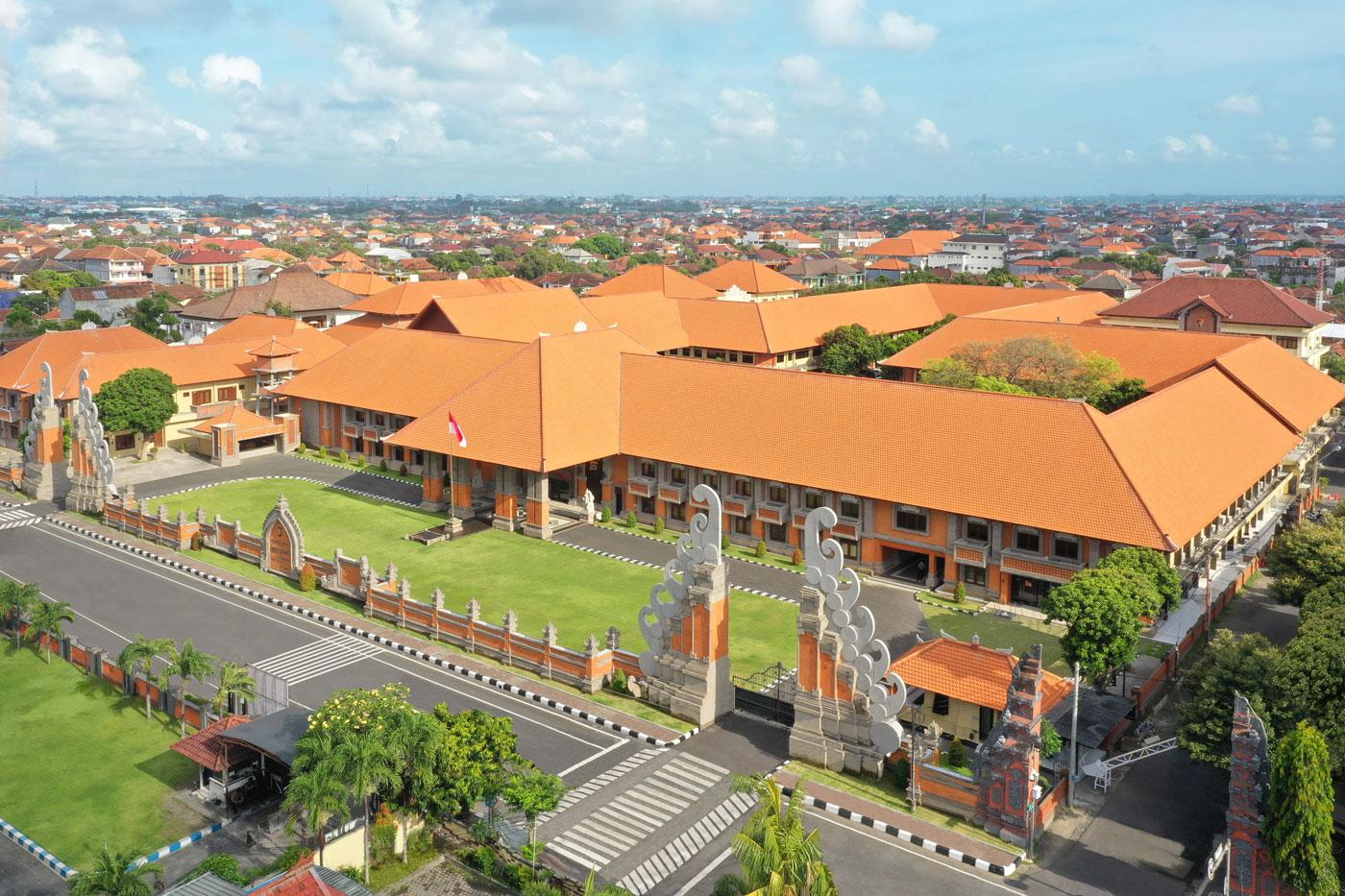
B A L I P O L I C E H E A D Q U A R T E R
"Modern yet rooted in local culture.
After a rigorous and extensive selection process, the Jeghier Architect team was appointed to redesign the Bali Regional Police Building with a theme of restoration and modernization. Situated in the heart of the Sumerta community in Denpasar City, on W.R. Supratman Street No. 7, the location is surrounded by traditional residences, community meeting halls (balai banjar), and temples (pura).
Traditional architecture in the Sumerta Village is constructed by local craftsmen using indigenous materials. The prevalent material is red brick, locally produced and fired. The softer natural stones, such as sandstone, are intricately carved and serve as ornaments, showcasing the local craftsmanship. The warm hues of the fired brick and the grey tones of the sandstone dominate the architecture of temples and residential homes.
The hot and dry weather during the dry season, as well as heavy rainfall in the rainy season, affect the durability of the natural materials used in the local construction. Building techniques and material assembly have been passed down through generations, forming the architectural culture. This necessitates frequent renovations and reconstructions of buildings. Despite the vulnerabilities to weather, the community remains loyal to these materials, reusing them in renovations. New craftsmen inherit their skills from previous generations, creating a strong sense of place for the Sumerta Village and reflecting the collective pride of the community in their architecture, a heritage nurtured over the years.
In alignment with this spirit of regionalism, the design of the Bali Regional Police Building adopts a similar approach, even though its function is not directly related to the traditional life of the local community. The police force is a modern institution but not detached from the roots of the nation's traditions.
The presence of the new Bali Regional Police Building complex is felt from afar. When passing through W.R. Supratman Street, two pairs of monumental 'candi bentar' serve as markers at the entrance to the office complex. Surrounding the site, walls with materials, architectural style, and construction techniques similar to 'candi bentar' stand firmly, interspersed with traditional paduraksa columns reinforcing land boundary walls.
The layout and floor plan reflect a hierarchical distribution based on traditional values yet accommodating modern activities.
The role of a security institution for a nation has existed since humans began living in communities. Each era has shaped different political systems, from traditional times and kingdoms to the present-day democratic state. The police force is one institution tasked with maintaining the security of the Unitary State of the Republic of Indonesia. The existence and role of this institution in safeguarding security can be traced back to the archipelago's territorial periods, including various kingdoms.
During the Majapahit Kingdom era, there was a unit responsible for maintaining the security of the kingdom and its apparatus. This unit was known as 'bhayangkara.' The role of security institutions can also be traced to the colonial and Japanese occupation periods.
The role of the police in Indonesia began since the early formation of the republic (Polri, 2020). Two days after Sukarno and Hatta proclaimed Indonesia's independence, the Preparation Committee for Indonesian Independence (PPKI) formed the State Police (BKN). This institution played two crucial roles in the early days of independence. Firstly, they were tasked with disarming the Japanese army, which had surrendered in the Pacific War. Additionally, the members of this institution had the noble task of uplifting the patriotic spirit of the armed forces units, which were in a state of depression after prolonged warfare. President Sukarno appointed R.S. Soekanto Tjokrodiatmodjo as the Head of the State Police (KKN) on September 29, 1945.
The name and position of the police in Indonesia underwent several adjustments (Polri, 2020). In the early days, this security institution was named the State Police Department and reported to two higher authorities. Administratively, they reported to the Ministry of Internal Affairs, while operationally, they answered to the Attorney General. Subsequent administrative changes positioned the State Police Department directly under the Prime Minister starting from July 1, 1946. This date is celebrated as Bhayangkara Day until today.
The history of the formation of the Indonesian National Police also went through the 1998 reform, marking the end of the New Order government and its replacement with the reform government led by BJ Habibie as the President. There was a demand for the separation of the police force from the Armed Forces of the Republic of Indonesia (ABRI) to establish it as a professional and independent institution, free from interference in law enforcement. Thus, Presidential Instruction No. 2 of 1999 separated the police force from ABRI. Since April 1, 1999, the Indonesian National Police has been under the Ministry of Defense.
Later, Presidential Decree No. VI/2000 and Presidential Decree No. VII/MPR/2000 regarding the roles of the TNI (Indonesian National Armed Forces) and the police stated that the police report directly to the President. Subsequently, in the history of the formation of the Indonesian National Police, Law No. 2 of 2002 regarding the Indonesian National Police was issued by President Megawati Soekarnoputri. This law strengthened the accountability of the Chief of Police to the President, required the approval of the DPR (People's Consultative Assembly) for the appointment of the Chief of Police, and established the National Police Commission to assist the President in policy-making and the selection of the Chief of Police.
The police force is prohibited from involvement in practical politics, and their voting rights are eliminated. They are subject to civilian court jurisdiction after going through military court proceedings. Internal reforms were also implemented, eliminating military characteristics, shifting paradigms to become a civil institution enforcing professional law, applying Human Rights, withdrawing the ABRI and Police factions from the DPR, changing doctrines, training, and police rank insignias. These changes are governed by Presidential Regulation No. 52 of 2010 on the Organization and Work Procedures of the Indonesian National Police.
Architecture and Identity Pride
Architecture has long been an integral part of a nation's history. It symbolizes the success, achievements, and grandeur of a nation (Dillon & Biesty, 2014). In classical times, great empires showcased their success and the superiority of their constructions by creating magnificent buildings with the best architects and materials at their disposal. Iconic architectural marvels like the pyramids in Egypt, the Parthenon in Greece, and the Borobudur temple in Central Java serve as testaments to the peak of the builder's dynasty, enduring for hundreds of years until today.
Architecture is also used as a marker of the extent of a nation's power. The Roman Empire, one of the largest in its time, conquered many regions and incorporated them into the Roman Empire. As a marker, in every region under their control, buildings with the distinctive architecture of the empire were constructed. To this day, Roman architecture is found scattered across Europe, parts of Asia, and Africa. This architecture represents the identity and glory of Rome in its time.
The power of architecture in evoking a sense of unity and national pride was well understood by the first President of Indonesia, Ir. Sukarno (Kusno, 2000). In the early days of independence, the President, originally from Bali, vigorously pursued physical development. Jakarta, as the Capital City, was redesigned to reflect the nation's culture and symbolize Indonesia's progress. Giant buildings were constructed with a new architectural style. In an effort to build national architectural pride, Sukarno, accompanied by his architectural pride F. Silaban, played a significant role in realizing colossal architecture in Indonesia in the early days of independence (Soepandi, 2017).
In the modern era, architecture becomes a measure of a nation's progress (Adam, 2012). After World War II, countries in America and Europe competed to create the most advanced buildings in terms of technology (Dupre & Smith, 2013). The benchmarks were the application of new materials, floor heights, construction speed, and the latest technology applied to the constructed buildings (Johnson & Dupree, 1996). Due to the focus on technology and speed, non-essential elements, such as ornaments, were considered useless. Architecture entirely adhered to the principles of rationality, efficiency, and logic (Frampton, 2007). This aligns with the post-World War II organizational work pattern emphasizing productivity. As a result of this race and the perspective on new architecture, similar-looking buildings emerged in many countries: boxes with steel or concrete structures covered with glass facades. Buildings of this style were then referred to as the international style, as they could be found almost all over the world. These buildings were accused of not respecting local rules and the culture that had existed and developed at the locations where these buildings were erected (Jencks, The Architecture of the Jumping Universe (paperback), 1995).
As a critique, the postmodern style emerged around the late 1960s. This new style sought to find roots in tradition and avoid uniform construction in different locations. It aimed for individualistic forms that were forbidden to imitate (Jencks, The Language of Post-Modern Architecture (Hardcover, 6th edition), 1991). Traditional ornaments were attached to buildings that inherently had a modern spirit to avoid a boxy impression. Pastel colors emerged as a contrast to the cool colors of glass and steel. Until the 1980s, the postmodern style was unsuccessful as it was considered only a fantasy to temporarily set aside the modern style. This style failed to evoke a 'sense of place,' a core criticism of the modern international style of architecture.
Efforts to apply technology while creating local space and atmosphere sparked debates about architecture. Efforts to create advanced architecture while maintaining local cultural roots and climate characteristics gave rise to what is known as critical regionalism. In this new style, architecture is not only concerned with vernacular architectural issues. It is a more progressive movement than neo-vernacular architecture, which is part of postmodernism. Critical regionalism seeks to mediate the spirit of the times that continues to progress and the local languages of architecture.
The spirit of Critical Regionalism in Bali was pioneered by the development of tourism accommodation facilities, especially in the Sanur area. Wija Waworuntu and Donald Friend believed that the modern architecture of Bali Hotels built in the late 1960s did not suit the landscape of the island. They then initiated tourism accommodation projects by commissioning Geoffrey Bawa, the most influential architect in South Asia at that time (Robinson & Bawa, 2002). Bawa drew inspiration from the local context by studying the tectonics of local architecture. A similar spirit was also shown by Peter Muller and continued by Kerry Hill (London, Finch, & Ojeda, 2013). Building modern facilities with profound attention to the local context then became a movement known as Bali Style (Helmi & Walker, 2003).
Architectural styles that emphasize local elements have proven successful in bringing Bali to the forefront of global architecture. The Bali Style has spread throughout Southeast Asia to the Pacific Islands. Additionally, as a method, Bali Style has continued from the 1960s to the present day. Recognizing the importance of local elements, the Bali Provincial Government even mandates that all buildings constructed in Bali respect the local context."
